Bereavement
Slide 1 of 17: Synopsis
Authors
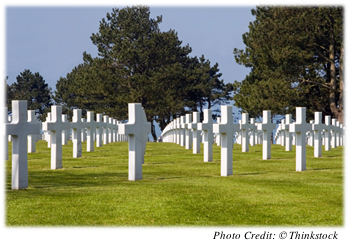
Catherine Robertson, Grossmont College
Raechel Soicher, American River College
Synopsis
In this activity, you will learn about the different aspects of how we respond to someone’s death. In videos, individuals describe their experiences of loss following the death of someone close. Experts discuss bereavement and outline some strategies for coping with loss.
References
Clements, P.T., Vigil, G.J., Manno, M.S., Henry, G.C., Wilks, J., Sarthak, D., Kellywood, R. & Foster, W. (2003). Cultural perspectives of death, grief, and bereavement. Journal of Psychosocial Nursing and Mental Health Services, 41, 18-26.
Cluver, L. & Gardner, F. (2007). Risk and protective factors for psychological well-being of children orphaned by AIDS in Cape Town: A qualitative study of children and caregivers’ perspectives. AIDS Care, 19, 318-325.
Cowles, K. (1996). Cultural perspectives of grief: An expanded concept analysis. Journal of Advanced Nursing, 23(2), 287-294.
Faschingbauer, T., Zisook, S., & DeVaul, R. (1987). The Texas revised inventory of grief. In S. Zisook (Ed.), Biopsychosocial aspects of bereavement (pp. 111-124). American Psychiatric Press, Inc.: Washington, D.C.
Faschingbauer, T. R., DeVaul, R. A., & Zisook, S. (1977). Development of the Texas inventory of grief. American Journal of Psychiatry, 134(6), 696-698.
Gallagher, D.E., Thompson, L.W. & Peterson, J.A. (1982). Psychosocial Factors Affecting Adaptation to Bereavement in the Elderly. The International Journal of Aging and Human Development, 14, 79-95.
Golden, T. (2000). Swallowed by a snake: The gift of the masculine side of healing. Gaithersburg, MD: Golden Healing Publishing.
Kastenbaum, R. (1998). Death, society, and human experience. Boston: Allyn and Bacon.
Kübler-Ross, E. (1997). On children and death. New York: Touchstone Books.
Kübler-Ross, E., & Gold, T. (1998). The wheel of life: A memoir of living and dying. New York: Simon and Schuster.
Lacy, B., & Sanderson, R. (1993). Grief: Getting over the death of someone close to you. Manhattan, KS: Kansas State University. Available at: http://www.k-state.edu/counseling/topics/life/grief.html
Maciejewski, P.K., Zhang, B., Block, S.D., & Prigerson, H. G. (2007). An Empirical Examination of the Stage Theory of Grief. The Journal of the American Medical Association, 297, 716-723.
National Cancer Institute (2002). Loss, grief, and bereavement. Available at: http://www.cancer.gov/cancertopics/pdq/supportivecare/bereavement/patient
Powell, T. (1997). Free yourself from harmful stress. New York: DK Publishing. Available online at: http://www.fema.gov/rebuild/recover/bereave.shtm
Texas Revised Inventory of Grief. CHITPS Assessment Instruments by topic. Available at: http://chipts.ucla.edu/assessment/Assessment_Instruments/Assessment_files_new/assess_trig.htm
Tousley, M. (2000). Understanding the grief process. Available at: http://dying.about.com/gi/dynamic/offsite.htm?site=http%3A%2F%2Fwww.griefhealing.com%2Fcolumn1.htm
Webb, M. (1999). The good death: The new American search to reshape the end of life. New York: Bantam Books.
Slide 2 of 17: Grief and Bereavement
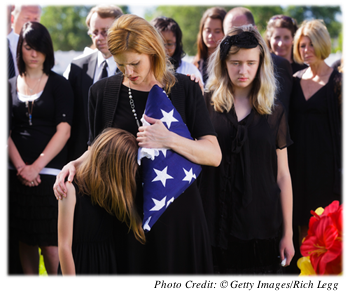
When someone we love dies, we experience an emotional response called grief. Grief is characterized by mental and emotional suffering. Each of us expresses our grief in a process referred to as bereavement, which is experienced in a different way and to a different extent by each individual. The manifestation of bereavement is influenced by our age or stage of development, personal experience, and social and cultural norms.
While individuals grieve, a community or cohort might also experience grief. Many people may be thrown together by events or circumstances, such as the 2001 World Trade Center bombing or international conflicts that take the lives of civilians and those in the military services.
Bereavement may be expressed through physical responses, such as lightheadedness, rapid heartbeat, or increased rate of breathing, and/or cognitive responses, such as confusion, disorientation, or difficulty concentrating. While grieving, we may experience anger, guilt, sadness, or fear.
Slide 3 of 17: Grief Inventory
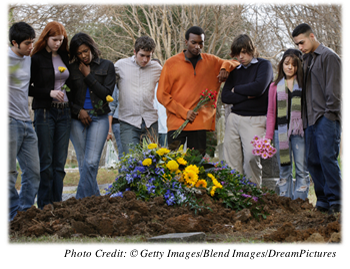
Using a standardized grief inventory, research on grieving has revealed:
• Women are more likely to score high on questions regarding past grief as are people who had someone pass away on whom they had depended for help providing for the family.
• Groups with high scores for questions regarding present grief are more likely to suffer illness as a result of their increased grief. Possibly, they experience delayed or unresolved grief.
• People who were able to go through a grieving process that included a funeral are more likely to score lower on the scale of past grief. This finding suggests that attendance at a funeral or service appears to help people to integrate the loss in a meaningful way with other experiences that one goes through in life.
Slide 4 of 17: The Grieving Process
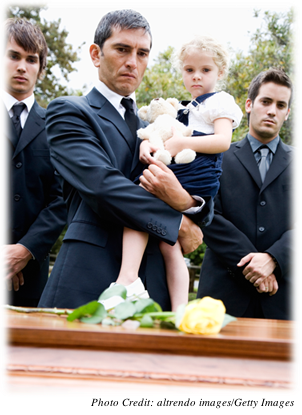
There are generally five stages to the grieving process. Grievers tend to progress through these stages in the following order:
1. disbelief – a period of denial that a loss has taken place;
2. yearning – an intense desire for the return of the deceased;
3. anger – outrage may be directed at self or the deceased;
4. depression – a period of intense sadness, numbness, and confusion;
5. acceptance – the final stage in which the person has accepted the loss of their loved one.
Slide 5 of 17: Factors Affecting Bereavement

How each individual experiences grief and expresses bereavement depends on a range of factors from income level, religious commitment, and strength of social network to age and relationship to the deceased (Gallagher, Thompson, & Peterson, 1982; Cluver & Gardner, 2007).
How we grieve is also affected by whether we have had another recent loss or even a string of losses over a short period as might occur in late adulthood. The stress from a number of losses tends to add up and may increase the intensity of the grief and bereavement.
Slide 6 of 17: Bereavement and Grief: Children and Adolescents
- Chapters
- descriptions off, selected
- captions settings, opens captions settings dialog
- captions off, selected
- English Captions
This is a modal window.
Beginning of dialog window. Escape will cancel and close the window.
End of dialog window.
This is a modal window. This modal can be closed by pressing the Escape key or activating the close button.
This is a modal window.
Since bereavement is an individual’s unique expression of grief, bereavement is dependent on the person’s cognitive understanding of what death is, and this understanding is dependent on his/her developmental stage. Therefore, a person’s emotional expression of grief is directly related to his/her developmental stage.
Slide 7 of 17: Bereavement and Grief: Early and Middle Adulthood
- Chapters
- descriptions off, selected
- captions settings, opens captions settings dialog
- captions off, selected
- English Captions
This is a modal window.
Beginning of dialog window. Escape will cancel and close the window.
End of dialog window.
This is a modal window. This modal can be closed by pressing the Escape key or activating the close button.
This is a modal window.
Grief and bereavement continue to change through the adult years.
Early adulthood: The reality of death is well understood but is a far-away thought. Generally, this is a period of peak health and well-being. Young adults are busy establishing a life that may include work, relationships, marriage, and children. With the first child, the reality of death emerges more prominently because the adult is now responsible for another life and may be anxious about something happening to the child. The actual expression of grief follows a normal adult pattern.
Middle adulthood: Death becomes more real at this stage because this is a time when some peers may begin to die. Many people consider making changes in an effort to lengthen their lives, such as improving diet, stopping smoking, losing weight, and exercising more. The death of parents generally becomes a reality if it has not already. Grief and bereavement may be intense if this is the first time that an adult has experienced profound loss.
Slide 8 of 17: Bereavement and Grief: Late Adulthood
- Chapters
- descriptions off, selected
- captions settings, opens captions settings dialog
- captions off, selected
- English Captions
This is a modal window.
Beginning of dialog window. Escape will cancel and close the window.
End of dialog window.
This is a modal window. This modal can be closed by pressing the Escape key or activating the close button.
This is a modal window.
Coming to grips with one’s own mortality is a developmental task at this stage. Older adults realize that death is inevitable, and engaging in a life review is a typical reaction to this acceptance. Bereavement may be a common companion during this life stage as losses occur with more frequency. The most common and most difficult loss that may occur during this phase is death of a long-term spouse. Grief over this loss may be very intense and may even cause sufficient physical and emotional suffering to actually threaten the griever’s health and life expectancy.
Keeping in mind the developmental stage of each person and the five stages of the grieving process that you have learned in this activity, listen carefully to how each person expresses grief in this video.
Slide 9 of 17: Bereavement and Grief: Late Adulthood
- Chapters
- descriptions off, selected
- captions settings, opens captions settings dialog
- captions off, selected
- English Captions
This is a modal window.
Beginning of dialog window. Escape will cancel and close the window.
End of dialog window.
This is a modal window. This modal can be closed by pressing the Escape key or activating the close button.
This is a modal window.
Coming to grips with one’s own mortality is a developmental task at this stage. Older adults realize that death is inevitable, and engaging in a life review is a typical reaction to this acceptance. Bereavement may be a common companion during this life stage as losses occur with more frequency. The most common and most difficult loss that may occur during this phase is death of a long-term spouse. Grief over this loss may be very intense and may even cause sufficient physical and emotional suffering to actually threaten the griever’s health and life expectancy.
Keeping in mind the developmental stage of each person and the five stages of the grieving process that you have learned in this activity, listen carefully to how each person expresses grief in this video.
Slide 10 of 17: The Social Viewpoint: Mourning
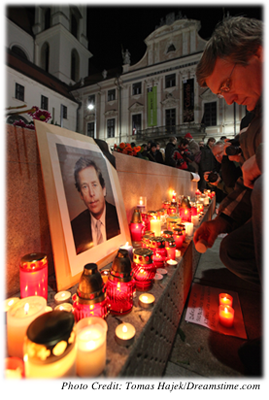
Bereavement has a social and cultural connection. In the United States and other Western nations, grief and bereavement following a death historically called for definite signs and symbols of mourning, which is the public expression of bereavement. In the past, the mourning process had social structure and social rules and was a public process that included a great deal of emotional display. This practice allowed for adequate recovery time, attention, and sympathy for the bereaved person(s).
Today, mourning and bereavement have become much more private, and the acceptable customs for a public level of emotional display have lessened. Consequently, a person who is feeling bereaved is often more socially isolated from the community and has limited opportunities for public expressions of grief. The lack of social support can make recovery from the loss much more difficult. The best way to help someone to recover is to provide sympathy and support and to acknowledge the pain of bereavement.
Slide 11 of 17: The Cultural Viewpoint

How individuals react to death seems to differ from one culture to another. How individuals bereave, mourn, and grieve is often closely related to the religions predominant in their culture. Cowles (1996) has found that despite cultural differences, the human experience of grief across cultures is more similar than different. The rituals and traditions surrounding the public display of mourning reveal the greatest perceptions of difference.
How individuals react to death seems to differ from one culture to another. How individuals bereave, mourn, and grieve is often closely related to the religions predominant in their culture. Cowles (1996) has found that despite cultural differences, the human experience of grief across cultures is more similar than different. The rituals and traditions surrounding the public display of mourning reveal the greatest perceptions of difference.
Slide 12 of 17: Coping with the Grieving Process
- Chapters
- descriptions off, selected
- captions settings, opens captions settings dialog
- captions off, selected
- English Captions
This is a modal window.
Beginning of dialog window. Escape will cancel and close the window.
End of dialog window.
This is a modal window. This modal can be closed by pressing the Escape key or activating the close button.
This is a modal window.
When we understand the grieving process and its function, we can assist grievers by offering sympathy and support and by acknowledging the pain of loss. Grief generally lessens over time. Dr. George Bonanno, a psychologist at Columbia University, has found that laughter can be a part of healing during the grief process.
Play the video to hear what Dr. George Bonanno advises for those who are experiencing grieving.
Slide 13 of 17: Summary
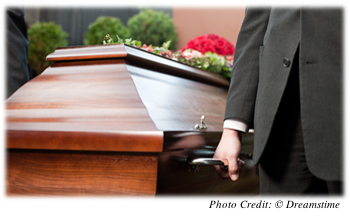
The death of a close relative or friend occurs sooner or later in everyone’s life. Social, cultural, and developmental factors affect how each of us expresses our grief through individual bereavement or in more public displays of mourning. These factors include the sense of loss, nature of the death, relationship and attachment to the deceased, personal history, developmental stage, personality, and whether we have had another recent loss.
Cultural differences may be most evident in the mourning process, but across cultures, people’s personal experience of grief is more similar than different.
There is a process of grieving that is common to adults, adolescents, and older children who are capable of understanding the reality of death. There are also coping mechanisms, such as laughter, that may help in healing those who grieve.
Slide 14 of 17: Assessment: Check Your Understanding

Slide 15 of 17: Assessment: Check Your Understanding

Slide 16 of 17: Assessment: Check Your Understanding

Slide 17 of 17: Assessment: Check Your Understanding

Congratulations! You have completed this activity.Total Score: x out of x points (x%) You have received a provisional score for your essay answers, which have been submitted to your instructor.